|
Miniature Portraits of the 19th Century:
What Did They Cost Then?
| By Don Shelton
Posted October 2012
|
 |
I have been asked to write about what it would have cost to have a miniature portrait painted in the 19th century. The answer is a bit like the fisherman's catch: it varied a great deal! It tended to be on a rising scale where the cost of the portrait rose with the stature of the artist and the depth of the client's pockets. We can leave on one side the question of family members who, as amateur artists, painted portraits of family members. Some of these were talented, but money did not enter into the equation.
Thus, at the bottom were the itinerant artists travelling through rural areas and small towns of America who would draw a profile portrait or a silhouette on paper in a few minutes for a few cents or a dollar. Few of these had any training as artists, and so, they developed their own readily recognizable and individual styles. The silhouettes would be in black and white only, but a profile might be colored and perhaps cost $5-$10. I do not know exactly how much they charged for their work, but American artists working in this manner included Justus DaLee (1793-1878), James Sanford Ellsworth (1802-1873), both of whom worked on paper, and the British immigrant James H Gillespie (active 1793-1838) who also painted on ivory. The work of DaLee and Ellsworth are now advertised for prices in the range of $2,000-$5,000. However, Gillespie portraits are more often in the range $750-$1,250.
|
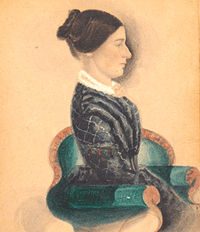
|
A miniature profile portrait by James Sanford Ellesworth. (Note: The largest of the miniatures depicted in the article is only 3 x 4 inches, and the others average 2 x 3 inches.)
|
This profile portrait by James Sanford Ellsworth is typical of his work with an unknown sitter wearing a black dress, seated on a stuffed green chair, and a dark cloud around her head; although with this example, that cloud is less apparent due to fading.
An interesting aside about such portraits is that despite being painted or drawn before the 1840 introduction of photography, they are sometimes inscribed as, “taken at _________ on _______ date”. Thus, proving the term to “take a portrait” arose well before the introduction of the camera.
From those artists, the base prices rose. For the better quality artists, a miniature portrait required several sittings and as much skill and time as a large oil portrait. In some respects, they required more skills, as mistakes made while painting an oil could be painted over, whereas with a miniature painted in watercolor on ivory, a mistake took much more skill and time to remedy.
|
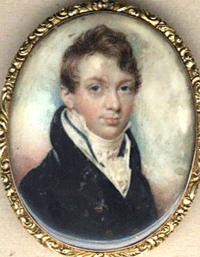
|
A painted miniature of an unknown man by Raphaelle Peale, it shows signs of surface damage after 200 years.
|
Raphaelle Peale (1774-1825) was a member of the famous Peale Family, being the eldest son of Charles Willson Peale (1741-1827) who is famous for his miniatures of early Americans, including one of George Washington in 1776. Although talented, Raphaelle did not have the dedication of his father.
Raphaelle was inclined to try out new techniques, and in 1803, he toured the South, taking with him a physiognotrace.
With this newly invented device, he could rapidly print small silhouette profiles on paper. He sold thousands, charging 25 cents for a set of four. But the novelty of the product quickly wore off, and his success faded.
|
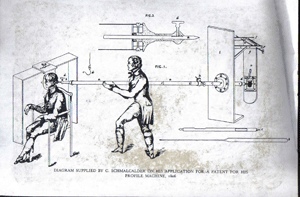
|
A physiognotrace for drawing silhouettes.
|
An example of a physiognotrace of Colonel Joseph Shippen by another American artist, Louis Lemet (1779-1832), is shown here. Charles Saint-Memin was another artist who used this technique to create and reproduce miniature portraits.
|
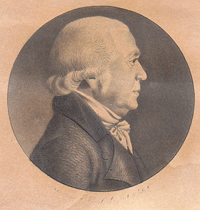
|
A miniature physiognotrace of Colonel Joseph Shippen by Louis Lemet, 2.25 inches in diameter.
|
Two of Raphaelle Peale's newspaper advertisements reflect his prices. One is from "Poulson's Daily Advertiser", Philadelphia, Penn., of Saturday, Jan 10, 1801. In it: "Raphaelle Peale, Portrait Painter in miniature and large, Will deliver likenesses for a short time, Fashionably set in Gold, with platts and cyphers complete, for twenty five dollars; miniatures alone, ten dollars. No 28 Powell Street, which is between Spruce and Pine, and running from Fifth to Sixth Streets."
The references to a “platt” and a “cipher” are to an ornate decoration of plaited hair on the reverse and a finely cut cypher of the sitter's initials. Thus, the cost of a miniature in an ornate frame with hair on the reverse was $25, whereas the miniature itself was only $10.
Another is a front-page advertisement from "Poulson's American Daily Advertiser" for November 5, 1821 and records: "RAPHAELLE PEALE, having returned to Philadelphia after an absence of 18 months, will paint portraits for a short time at the following prices: - Portraits in oils, $20; in miniature on ivory, $15; profiles colored on Ivory Paper, $3; Likeness, after death, $50; Fifteen or twenty minutes with the deceased is all the time necessary to obtain means of having a faithful likeness."
This ad is interesting in several respects: it indicates the charges made by Raphaelle Peale with a rise in his price from $10 to $15; shows he was painting miniatures much later than reference literature generally states; and refers to the practice of painting portraits of deceased persons after their death.
Although painting a deceased person could not have been pleasant, some artists charged a significant premium for them, perhaps thereby taking advantage of bereaved relatives who had to make up their minds very quickly. As death in childbirth was common in those days, many of the deceased the artist was asked to paint would have unfortunately died in childbirth. Later, after 1840, the urgency was slightly less as it was possible to take post-mortem photographs or base a miniature on an earlier daguerreotype, if one was available.
The better-skilled artists learned as apprentices, and in the larger cities, they could earn a good living. John Wood Dodge (1807-1893) kept a detailed record book from 1828 to1864 detailing 1,100 miniatures, an average of two or three per month. In 1803, Anson Dickinson (1779-1852) charged $20-$25 per miniature, and Edward Greene Malbone (1777-1807) charged $50. Nathaniel Rogers (1787-1844) was another prolific artist who worked in the New York area.
Generally, artists charged more for a miniature with more than one sitter. Hence, this miniature of three children by Nathaniel Rogers would have probably cost in the range of $50 to $100.
|
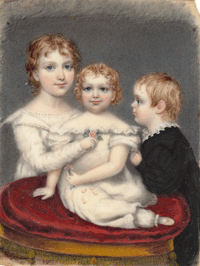
|
More than one sitter significantly increased the price of a miniature, as with this portrait of three children.
|
The introduction of the daguerreotype, with portraits costing perhaps a dollar or two, made it very difficult for artists to compete, and most of them either gave up painting or switched to become photographers. There was an explosion in the demand for likenesses due to such a lower cost, and accurate likenesses were then available to families who could not previously afford to pay for painted miniatures.
Sadly, it was not realised that photographs would not last as long as miniatures on ivory. Hence, many daguerreotypes, which must have seemed wonderful likenesses at the time, have since deteriorated from the effects of water and time on the residual chemicals remaining on the base portrait.
Few painters could survive the onslaught of photography. One who managed to hold out against it for many years was John Henry Brown (1818-1891). He concentrated on wealthy families who wanted color portraits, and he aimed to match the fine detail of photographs, but he painted them in color. He became noted for his attention to detail, effectively an early form of photo-realism, but it took him a long time and many sittings to achieve the desired result. In 1860, he charged an average of $180 for a portrait and up to $280 for a portrait of two children. He painted several miniatures of deceased people from daguerreotypes during 1860 and charged less for them, $125-$155, presumably as in those instances the sitter was less likely to complain!
During the year 1860, Brown painted 20 miniatures, but it took him three weeks to paint a single portrait. Brown's diary records the process on one portrait: “May 2, Had a Daguerreotype taken of Mrs Gen Cadwalader.” On May 3, “Commenced Mrs Cadwalader's picture.” He then worked on it every day, excluding Sundays, and finished it on Saturday May 19. The lacework on the miniature of Maria Charlotte Gouverneur Cadwalader shows why it took so long. (Maria’s aunt on her mother's side was married to President James Monroe, so she was well connected.)
|
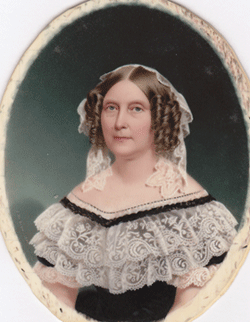
|
Maria Charlotte Gouverneur Cadwalader (1801-1861) painted by John Henry Brown (1818-1891). This required about 15 days of artistic work, and it measured 3 inches wide by 4 inches high. Note the delicate artistry of Maria’s lace. Brown’s signature is on the border just below her right shoulder. Can you see it?
|
It is not easy to grasp the cost of miniatures expressed in 19th century currency since monetary values have changed much since 1821. To give some perspective to charges for painting a miniature, it is interesting to refer to page 158 of Bishop Davenport's Gazetteer published in 1832. This lists the pay per day for senators and representatives from each state of the then United States. Their pay ranged from $1.50 to $4 per day, with an apparent average of around $3 per day. Allowing for a little inflation between 1821 and 1832, it seems that a miniature on ivory costing $20 was therefore equivalent to about a week's remuneration for a senator or representative. According to Wikipedia, the 2006 base remuneration level for Senators and Representatives was $165,000 per year, which is a little over $3,000 per week. Thus, it can be seen that a miniature on ivory was an expensive item in 1821 and equivalent to around $3,000 now, even before the cost of the frame.
The frame could more than double the cost. In 1801, Raphaelle Peale charged $10 for a miniature unframed and $25 in an ornate frame with hair on the reverse. Reproduction frames can now cost around $500 without hair decoration on the reverse. Later American frames of 1830-1850 were made with very small rear windows on the reverse, presumably to keep the cost of hair-work to a minimum. Thus, inclusive of a reasonably ornate frame, although not one of those with a hair decoration on the reverse, one can say that the cost of a miniature on ivory, painted in 1820 for $15 by Raphaelle Peale, was equivalent to around $3,000-$4,000 in today's money. However, given his charge of $50, a likeness painted of a deceased person was more expensive, equivalent to more than $5,000 in today's money.
Compared to that, modern prices are not expensive for such a permanent heirloom. The modern miniature painter Wes Siegrist advises, “Professional modern miniature painters will typically charge more for human portraits due to time and complexity. Their reputation will factor into it as well. I'm not familiar with everyone's specific prices, but I would guess that $500 would be on the low end and $2,000 on the high end for a commission, perhaps even higher at retail. Most commissions will be $1,200 or less. Prices may include framing, but double check.”
For those seeking an area to collect, miniature portraits are still available at modest prices when related to the skill required to paint them and the history involved. A fascinating aspect of collecting is to research the lives of known sitters via the Internet. With my own collection, I post this information on my website and quite often receive messages from descendants of sitters who have been thrilled to find more information about their family history.
----------------------------
Don Shelton is a private collector of miniature portraits who lives in New Zealand. Since he purchased his first American miniature in 2000, he has developed a particular interest in them and now has more than 300 American miniatures in his collection. However, he readily concedes collecting them has kept him cash poor and pleasure rich. Readers with a greater interest in miniature portraits can view his full collection on the Internet at www.portrait-miniature.blogspot.com. There, he is willing to answer questions about miniatures, especially for those who have family portraits they wish to know more about.
All photos, courtesy of Don Shelton.
|